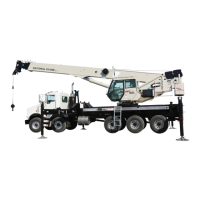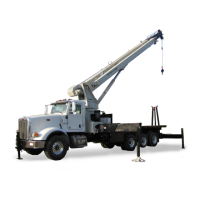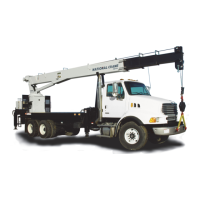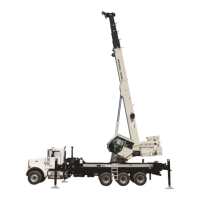National Crane Published 4-23-2018 Control # 239-11 3-19
NBT40 SERIES OPERATOR MANUAL OPERATING CONTROLS & PROCEDURES
A boom extension capacity chart and notes are included to
list the capacities for the extension length, load radius, and
boom angle.
Another section contains the notes for lifting capacities. Be
sure to read and understand all the notes concerning lifting
capacities.
The load chart also gives weight reductions for load
handling devices such as hook blocks, headache balls,
boom extensions, etc., which must be taken into
consideration as part of the load. Remember, the weight of
any other load handling devices such as chains, slings, or
spreader bars must be added to the weight of the load.
LIFTING THE LOAD
The following general guidelines outline the proper
procedure for making a lift after the crane has been properly
set up.
1. Position the crane in the work area and set the
outriggers. See “Outrigger Setup” on page 2-14 for
outrigger setup.
2. Program the RCL. Use the load chart to estimate the
values.
3. Position the boom nose over the load. Do not try and
drag the load with the boom or hoist.
4. Perform the lift. Meter the controls when moving the load
to avoid sudden stops.
5. Retract and lower the boom after the lift is complete.
SHUT DOWN AND PREPARATION FOR
ROAD TRAVEL
1. Ensure the swingaway, if so equipped, is properly
stowed and secured or removed from crane.
2. Retract and place the boom in boom rest.
3. Ensure the center front stabilizer is fully retracted, if
equipped.
4. Ensure the outrigger beams and jacks are fully retracted
with the floats properly stowed.
5. Engage the mechanical travel lock at each outrigger
beam.
6. Engage the swing brake.
7. Engage the swing lock.
8. Either the hook block may be reeved over the main
boom nose or the headache ball may be reeved over the
main boom nose or auxiliary boom nose; the other must
be removed and stowed securely before travelling. If the
hook block or headache ball remains reeved on the
boom, it must be secured at the tie down on the carrier
provided for that purpose.
9. Secure the hook block and A2B weight:
a. Slowly hoist up until there is a slight tension on the
hoist cable. It may be necessary to override the A2B
function to tension the cable.
CAUTION
Disengage the hydraulic pumps for extended traveling,
cold weather starting, or engine checks.
Check cold tire pressure prior to extended travel. Refer to
tire inflation decal on crane.
CAUTION
Machine Damage Hazard!
Do not travel with an empty hook in a position where it can
swing freely. Either remove the hook block and/or
headache ball from the hoist cable(s) and stow securely
or make sure the hook block or headache ball is properly
secured to the tie down provided for that purpose.
Fully retract the outrigger jacks and properly store the
floats.
WARNING
Do not travel with swingaway extended to prevent
damage to equipment.
Failure to comply with these instructions may cause death
or serious injury.
CAUTION
Outrigger beams must be pinned for travel.
If not pinned, outrigger beams may drift out during travel.
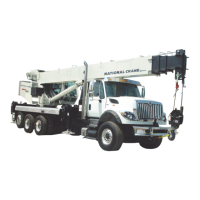
